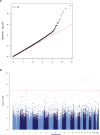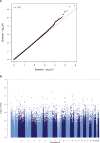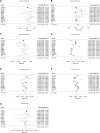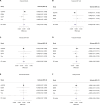Cesarean delivery and blood DNA methylation at birth and childhood: Meta-analysis in the Pregnancy and Childhood Epigenetics Consortium
- PMID: 39602535
- PMCID: PMC11601205
- DOI: 10.1126/sciadv.adr2084
Cesarean delivery and blood DNA methylation at birth and childhood: Meta-analysis in the Pregnancy and Childhood Epigenetics Consortium
Abstract
Children born via cesarean delivery have a higher risk of metabolic, immunological, and neurodevelopmental disorders compared to those born via vaginal delivery, although mechanisms remain unclear. We conducted a meta-analysis of epigenome-wide association studies to examine the associations between delivery mode and blood DNA methylation at birth and its persistence in early childhood. Participants were from 19 pregnancy cohorts (9833 term newborns) and 6 pediatric cohorts (2429 children aged 6 to 10 years). We identified six CpGs in cord blood associated with cesarean delivery (effect size range: 0.4 to 0.7%, P < 1.0 × 10-7): MAP2K2 (cg19423175), LIM2 (cg01500140), CNP (cg13917614), BLM (cg18247172), RASA3 (cg22348356), and RUNX3 (cg20674490), independent of cell proportions and other confounders. In childhood, none of these CpGs were associated with cesarean delivery, and no additional CpGs were identified. Delivery mode was associated with cell proportions at birth but not in childhood. Further research is needed to elucidate cesarean delivery's molecular influence on offspring health.
Figures




References
-
- World Health Organization (2021); www.who.int/news/item/16-06-2021-caesarean-section-rates-continue-to-ris....
-
- Sandall J., Tribe R. M., Avery L., Mola G., Visser G. H., Homer C. S., Gibbons D., Kelly N. M., Kennedy H. P., Kidanto H., Taylor P., Temmerman M., Short-term and long-term effects of caesarean section on the health of women and children. Lancet 392, 1349–1357 (2018). - PubMed
-
- Cho C. E., Norman M., Cesarean section and development of the immune system in the offspring. Am. J. Obstet. Gynecol. 208, 249–254 (2013). - PubMed
Publication types
MeSH terms
Grants and funding
LinkOut - more resources
Full Text Sources
Medical
Miscellaneous

